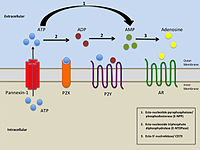
Photo from wikipedia
Study Objective and Hypothesis: Macroautophagy is a process that degrades unwanted cellular components (cargo) to maintain tissue homeostasis. It operates basally but is upregulated under stressful conditions such as nutrient… Click to show full abstract
Study Objective and Hypothesis: Macroautophagy is a process that degrades unwanted cellular components (cargo) to maintain tissue homeostasis. It operates basally but is upregulated under stressful conditions such as nutrient deprivation. Myocardial autophagy is cardioprotective, whereas its downregulation can cause cardiomyopathy. We have previously shown that the G protein-coupled estrogen receptor 1 (GPER, aka GPR30) exerts both estrogen-dependent and estrogen-independent effects on components of Ca2+ signaling in the cardiovascular system. However, if and how GPER regulates myocardial autophagy is completely unknown. Here, we tested the hypothesis that GPER promotes myocardial autophagy in an estrogen-independent fashion. Methods: Cardiomyocytes were freshly isolated from male adult C57BL/6 wildtype (WT) and GPER-/- mice. Autophagy was assessed using the autophagic flux assay. Activities of upstream regulators such as mTOR and AMPK were assessed by immunoblotting. Starvation-induced Ca2+ signal (SICS) was measured by monitoring fractional indo-1 signal before and after amino acid removal. Lysosomal pH was assessed using LysoSensor Yellow/Blue DND160. In overexpression paradigms, comparisons of SICS and lysosomal pH were made between WT and GPER-overexpressing cells in the same microscopic fields in all experiments. Results: In the absence of estrogen or a GPER agonist, basal autophagic flux was lower by 13.17 ± 0.72-fold in freshly isolated GPER-/- vs WT cardiomyocytes (p < 0.0001, n = 3). There were no significant differences in the activities of mTOR or AMPK between WT and GPER-/- cardiomyocytes (n = 6, p > 0.05). However, basal lysosomal pH was significantly higher in GPER-/- cardiomyocytes, with lysosensor ratio of 1.41 ± 0.11 vs 1.21 ± 0.12 in WT cells (n = 64; p < 0.0001), consistent with the reduction in autophagic flux. There was no significant difference in basal cytoplasmic Ca2+ levels between WT and GPER-/- cardiomyocytes (n = 53, p = 0.31). However, SICS was larger in WT (SICS AUC = 441 ± 94) than in GPER-/- (SICS AUC = 177 ± 49) cardiomyocytes (n = 25, p< 0.05). In the absence of estrogen or a GPER agonist, overexpression of ECFP-tagged GPER in HEK293 cells suppressed SICS (SICS AUC = 4.73 ± 4.27 vs 18.05 ± 7.41 in WT cells, n = 27, p < 0.0001). Lysosomal pH is significantly lower in GPER-overexpressing cells compared to non-transfected cells in both fed condition and following 30 s, 1 min, 2 min and 5 min of amino acid starvation (n = 20-26, p < 0.0001). Truncation of the PDZ-binding motif in GPER did not affect the inhibition of SICS or promotion of lysosomal acidification that are caused by expression of full-length GPER. Conclusion: These results indicate that GPER produces estrogen-independent effects to influence myocardial autophagy, likely via regulating Ca2+ signaling and lysosomal acidification. The molecular mechanism whereby GPER exerts these effects remains to be elucidated. Iowa Osteopathic & Educational Research Fund #03-20-08 to Q-KT This is the full abstract presented at the American Physiology Summit 2023 meeting and is only available in HTML format. There are no additional versions or additional content available for this abstract. Physiology was not involved in the peer review process.
Journal Title: Physiology
Year Published: 2023
Link to full text (if available)
Share on Social Media: Sign Up to like & get
recommendations!